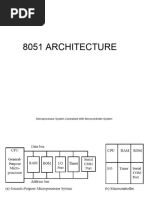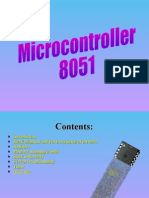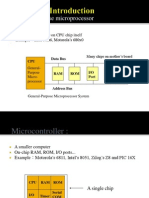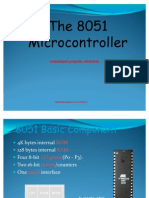0 ratings0% found this document useful (0 votes)
53 viewsThe 8051 Microcontroller Architecture
The document provides an overview of the 8051 microcontroller architecture including:
- A block diagram showing the CPU, RAM, ROM, I/O ports, timers, and serial port.
- Descriptions of the various registers including the program status word register.
- Explanations of the pins including power, clock, reset, and I/O ports.
- Details on memory organization, timers, interrupts, and the stack.
- Examples of machine cycle timing and simulator diagrams.
Uploaded by
superbs1001Copyright
© © All Rights Reserved
Available Formats
Download as PPT, PDF, TXT or read online on Scribd
0 ratings0% found this document useful (0 votes)
53 viewsThe 8051 Microcontroller Architecture
The document provides an overview of the 8051 microcontroller architecture including:
- A block diagram showing the CPU, RAM, ROM, I/O ports, timers, and serial port.
- Descriptions of the various registers including the program status word register.
- Explanations of the pins including power, clock, reset, and I/O ports.
- Details on memory organization, timers, interrupts, and the stack.
- Examples of machine cycle timing and simulator diagrams.
Uploaded by
superbs1001Copyright
© © All Rights Reserved
Available Formats
Download as PPT, PDF, TXT or read online on Scribd
You are on page 1/ 30
Lecture 2
The 8051 Microcontroller architecture
Contents:
Introduction
Block Diagram and Pin Description of the 8051
Registers
Some Simple Instructions
Structure of Assembly language and Running
an 8051 program
Memory mapping in 8051
8051 Flag bits and the PSW register
Addressing Modes
16-bit, BCD and Signed Arithmetic in 8051
Stack in the 8051
LOOP and JUMP Instructions
CALL Instructions
I/O Port Programming
1. meeting the computing needs of the task efficiently and cost
effectively
speed, the amount of ROM and RAM, the number of I/O ports
and timers, size, packaging, power consumption
easy to upgrade
cost per unit
2. availability of software development tools
assemblers, debuggers, C compilers, emulator, simulator,
technical support
3. wide availability and reliable sources of the microcontrollers.
Three criteria in Choosing a Microcontroller
The 8051 microcontroller
a Harvard architecture (separate instruction/data
memories)
single chip microcontroller (C)
developed by Intel in 1980 for use in embedded
systems.
today largely superseded by a vast range of faster
and/or functionally enhanced 8051-compatible
devices manufactured by more than 20
independent manufacturers
Block Diagram
CPU
On-chip
RAM
On-chip
ROM for
program
code
4 I/O Ports
Timer 0
Serial
Port
OSC
Interrupt
Control
External interrupts
Timer 1
Timer/Counter
Bus
Control
TxD RxD
P0 P1 P2 P3
Address/Data
Counter
Inputs
Feature 8051 8052 8031
ROM (program space in bytes) 4K 8K 0K
RAM (bytes) 128 256 128
Timers 2 3 2
I/O pins 32 32 32
Serial port 1 1 1
Interrupt sources 6 8 6
Comparison of the 8051 Family Members
Pin Description of the 8051
1
2
3
4
5
6
7
8
9
10
11
12
13
14
15
16
17
18
19
20
40
39
38
37
36
35
34
33
32
31
30
29
28
27
26
25
24
23
22
21
P1.0
P1.1
P1.2
P1.3
P1.4
P1.5
P1.6
P1.7
RST
(RXD)P3.0
(TXD)P3.1
(T0)P3.4
(T1)P3.5
XTAL2
XTAL1
GND
(INT0)P3.2
(INT1)P3.3
(RD)P3.7
(WR)P3.6
Vcc
P0.0(AD0)
P0.1(AD1)
P0.2(AD2)
P0.3(AD3)
P0.4(AD4)
P0.5(AD5)
P0.6(AD6)
P0.7(AD7)
EA/VPP
ALE/PROG
PSEN
P2.7(A15)
P2.6(A14)
P2.5(A13)
P2.4(A12)
P2.3(A11)
P2.2(A10)
P2.1(A9)
P2.0(A8)
8051
(8031)
Pins of 80511/4
Vccpin 40
Vcc provides supply voltage to the chip.
The voltage source is +5V.
GNDpin 20ground
XTAL1 and XTAL2pins 19,18
These 2 pins provide external clock.
Way 1using a quartz crystal oscillator
Way 2using a TTL oscillator
Example 4-1 shows the relationship between XTAL
and the machine cycle.
Pins of 80512/4
RSTpin 9reset
It is an input pin and is active highnormally low.
The high pulse must be high at least 2 machine cycles.
It is a power-on reset.
Upon applying a high pulse to RST, the microcontroller will
reset and all values in registers will be lost.
Reset values of some 8051 registers
Way 1Power-on reset circuit
Way 2Power-on reset with debounce
Pins of 80513/4
/EApin 31external access
There is no on-chip ROM in 8031 and 8032 .
The /EA pin is connected to GND to indicate the code is stored
externally.
/PSEN ALE are used for external ROM.
For 8051, /EA pin is connected to Vcc.
/ means active low.
/PSENpin 29program store enable
This is an output pin and is connected to the OE pin of the ROM.
See Chapter 14.
Pins of 80514/4
ALEpin 30address latch enable
It is an output pin and is active high.
8051 port 0 provides both address and data.
The ALE pin is used for de-multiplexing the address and data by
connecting to the G pin of the 74LS373 latch.
I/O port pins
The four ports P0, P1, P2, and P3.
Each port uses 8 pins.
All I/O pins are bi-directional.
Figure 4-2 (a). XTAL Connection to 8051
C2
30pF
C1
30pF
XTAL2
XTAL1
G
N
D
Using a quartz crystal oscillator
We can observe the frequency on the XTAL2 pin.
Figure 4-2 (b). XTAL Connection to an External Clock
Source
N
C
EXTERNAL
OSCILLATOR
SIGNAL
XTAL2
XTAL1
GND
Using a TTL oscillator
XTAL2 is unconnected.
RESET Value of Some 8051 Registers:
0000 DPTR
0007 SP
0000 PSW
0000 B
0000 ACC
0000 PC
Reset Value Register
RAM are all zero.
Figure 4-3 (a). Power-On RESET Circuit
30 pF
30 pF
8.2 K
10 uF
+
Vcc
11.0592 MHz
EA/VPP
X1
X2
RST
31
19
18
9
Figure 4-3 (b). Power-On RESET with Debounce
EA/VPP
X1
X2
RST
Vcc
10 uF
8.2 K
30 pF
9
31
Pins of I/O Port
The 8051 has four I/O ports
Port 0 pins 32-39P0P0.0P0.7
Port 1pins 1-8 P1P1.0P1.7
Port 2pins 21-28P2P2.0P2.7
Port 3pins 10-17P3P3.0P3.7
Each port has 8 pins.
Named P0.X X=0,1,...,7, P1.X, P2.X, P3.X
ExP0.0 is the bit 0LSBof P0
ExP0.7 is the bit 7MSBof P0
These 8 bits form a byte.
Each port can be used as input or output (bi-direction).
Registers
A
B
R0
R1
R3
R4
R2
R5
R7
R6
DPH DPL
PC
DPTR
PC
Some 8051 16-bit Register
Some 8-bitt Registers of
the 8051
Memory Map (RAM)
CPU timing
Most 8051 instructions are executed in one cycle.
MUL (multiply) and DIV (divide) are the only
instructions that take more than two cycles to complete (four
cycles)
Normally two code bytes are fetched from the program memory
during every machine cycle.
The only exception to this is when a MOVX instruction is
executed. MOVX is a one-byte, 2-cycle instruction that accesses
external data memory.
During a MOVX, the two fetches in the second cycle are
skipped while the external data memory is being addressed and
strobed.
8051 machine cycle
Example :
Find the machine cycle for
(a) XTAL = 11.0592 MHz
(b) XTAL = 16 MHz.
Solution:
(a) 11.0592 MHz / 12 = 921.6 kHz;
machine cycle = 1 / 921.6 kHz = 1.085 s
(b) 16 MHz / 12 = 1.333 MHz;
machine cycle = 1 / 1.333 MHz = 0.75 s
Edsim51 emulator diagram
KitCON-515 schematic
Timers
8051 has two 16-bit on-chip timers that can be
used for timing durations or for counting
external events
The high byte for timer 1 (TH1) is at address
8DH while the low byte (TL1) is at 8BH
The high byte for timer 0 (TH0) is at 8CH while
the low byte (TL0) is at 8AH.
Timer Mode Register (TMOD) is at address
88H
Timer Mode Register
Bit 7: Gate bit; when set, timer only runs while \INT high.
(T0)
Bit 6: Counter/timer select bit; when set timer is an event
counter when cleared timer is an interval timer (T0)
Bit 5: Mode bit 1 (T0)
Bit 4: Mode bit 0 (T0)
Bit 3: Gate bit; when set, timer only runs while \INT high.
(T1)
Bit 2: Counter/timer select bit; when set timer is an event
counter when cleared timer is an interval timer (T1)
Bit 1: Mode bit 1 (T1)
Bit 0: Mode bit 0 (T1)
Timer Modes
M1-M0: 00 (Mode 0) 13-bit mode (not
commonly used)
M1-M0: 01 (Mode 1) - 16-bit timer mode
M1-M0: 10 (Mode 2) - 8-bit auto-reload mode
M1-M0: 11 (Mode 3) Split timer mode
8051 Interrupt Vector Table
The Stack and Stack Pointer
The Stack Pointer, like all registers except DPTR and PC, may hold an 8-bit (1-byte)
value.
The Stack Pointer is used to indicate where the next value to be removed from the
stack should be taken from.
When you push a value onto the stack, the 8051 first increments the value of SP and
then stores the value at the resulting memory location.
When you pop a value off the stack, the 8051 returns the value from the memory
location indicated by SP, and then decrements the value of SP.
This order of operation is important. When the 8051 is initialized SP will be initialized
to 07h. If you immediately push a value onto the stack, the value will be stored in
Internal RAM address 08h. This makes sense taking into account what was mentioned
two paragraphs above: First the 8051 will increment the value of SP (from 07h to 08h)
and then will store the pushed value at that memory address (08h).
SP is modified directly by the 8051 by six instructions: PUSH, POP, ACALL, LCALL,
RET, and RETI. It is also used intrinsically whenever an interrupt is triggered
You might also like
- The 8051 Microcontroller: (Please Ignore Repeated Slides If Any. Also, Refer Text Too While Studying All The Slides)No ratings yetThe 8051 Microcontroller: (Please Ignore Repeated Slides If Any. Also, Refer Text Too While Studying All The Slides)78 pages
- The 8051 Microcontroller Architecture: ContentsNo ratings yetThe 8051 Microcontroller Architecture: Contents15 pages
- 8051 Architecture Contains The Following:: Block DiagramNo ratings yet8051 Architecture Contains The Following:: Block Diagram17 pages
- 8051 Pin Configaration and ArchitectureNo ratings yet8051 Pin Configaration and Architecture59 pages
- The 8051 Microcontroller: Prepared By, R-Thandaiah Prabu M.E., Lecturer - ECENo ratings yetThe 8051 Microcontroller: Prepared By, R-Thandaiah Prabu M.E., Lecturer - ECE46 pages
- Microprocessor and Interfacing ECX 4236 PDFNo ratings yetMicroprocessor and Interfacing ECX 4236 PDF37 pages
- 8051 Microcontroller Objectives: Understand The 8051 Architecture Use SFR in C Use I/O Ports in CNo ratings yet8051 Microcontroller Objectives: Understand The 8051 Architecture Use SFR in C Use I/O Ports in C60 pages
- The 8051 Microcontroller: Lets EXPLORE Inside 8051 !!No ratings yetThe 8051 Microcontroller: Lets EXPLORE Inside 8051 !!45 pages
- The 8051 Microcontroller: Hsabaghianb at Kashanu - Ac.ir100% (1)The 8051 Microcontroller: Hsabaghianb at Kashanu - Ac.ir141 pages
- EIOT UNIT 1 - Pin Diagram and Architecture of 8051No ratings yetEIOT UNIT 1 - Pin Diagram and Architecture of 805113 pages
- Programmable Logic Controllers: A Practical Approach to IEC 61131-3 using CoDeSysFrom EverandProgrammable Logic Controllers: A Practical Approach to IEC 61131-3 using CoDeSysNo ratings yet
- Practical Reverse Engineering: x86, x64, ARM, Windows Kernel, Reversing Tools, and ObfuscationFrom EverandPractical Reverse Engineering: x86, x64, ARM, Windows Kernel, Reversing Tools, and ObfuscationNo ratings yet
- Preliminary Specifications: Programmed Data Processor Model Three (PDP-3) October, 1960From EverandPreliminary Specifications: Programmed Data Processor Model Three (PDP-3) October, 1960No ratings yet
- Exploring BeagleBone: Tools and Techniques for Building with Embedded LinuxFrom EverandExploring BeagleBone: Tools and Techniques for Building with Embedded Linux4/5 (2)
- Mega Drive Architecture: Architecture of Consoles: A Practical Analysis, #3From EverandMega Drive Architecture: Architecture of Consoles: A Practical Analysis, #3No ratings yet
- Radio Shack TRS-80 Expansion Interface: Operator's Manual Catalog Numbers: 26-1140, 26-1141, 26-1142From EverandRadio Shack TRS-80 Expansion Interface: Operator's Manual Catalog Numbers: 26-1140, 26-1141, 26-1142No ratings yet
- A New Peak Power Tracker For Cost-Effective Photovoltaic Power SystemNo ratings yetA New Peak Power Tracker For Cost-Effective Photovoltaic Power System6 pages
- World Overview Building-Integrated PhotovoltaicsNo ratings yetWorld Overview Building-Integrated Photovoltaics6 pages
- The 8051 Microcontroller: (Please Ignore Repeated Slides If Any. Also, Refer Text Too While Studying All The Slides)The 8051 Microcontroller: (Please Ignore Repeated Slides If Any. Also, Refer Text Too While Studying All The Slides)
- 8051 Architecture Contains The Following:: Block Diagram8051 Architecture Contains The Following:: Block Diagram
- The 8051 Microcontroller: Prepared By, R-Thandaiah Prabu M.E., Lecturer - ECEThe 8051 Microcontroller: Prepared By, R-Thandaiah Prabu M.E., Lecturer - ECE
- 8051 Microcontroller Objectives: Understand The 8051 Architecture Use SFR in C Use I/O Ports in C8051 Microcontroller Objectives: Understand The 8051 Architecture Use SFR in C Use I/O Ports in C
- The 8051 Microcontroller: Lets EXPLORE Inside 8051 !!The 8051 Microcontroller: Lets EXPLORE Inside 8051 !!
- The 8051 Microcontroller: Hsabaghianb at Kashanu - Ac.irThe 8051 Microcontroller: Hsabaghianb at Kashanu - Ac.ir
- EIOT UNIT 1 - Pin Diagram and Architecture of 8051EIOT UNIT 1 - Pin Diagram and Architecture of 8051
- Programmable Logic Controllers: A Practical Approach to IEC 61131-3 using CoDeSysFrom EverandProgrammable Logic Controllers: A Practical Approach to IEC 61131-3 using CoDeSys
- Practical Reverse Engineering: x86, x64, ARM, Windows Kernel, Reversing Tools, and ObfuscationFrom EverandPractical Reverse Engineering: x86, x64, ARM, Windows Kernel, Reversing Tools, and Obfuscation
- Analog Dialogue, Volume 48, Number 1: Analog Dialogue, #13From EverandAnalog Dialogue, Volume 48, Number 1: Analog Dialogue, #13
- Preliminary Specifications: Programmed Data Processor Model Three (PDP-3) October, 1960From EverandPreliminary Specifications: Programmed Data Processor Model Three (PDP-3) October, 1960
- Exploring BeagleBone: Tools and Techniques for Building with Embedded LinuxFrom EverandExploring BeagleBone: Tools and Techniques for Building with Embedded Linux
- Mega Drive Architecture: Architecture of Consoles: A Practical Analysis, #3From EverandMega Drive Architecture: Architecture of Consoles: A Practical Analysis, #3
- Radio Shack TRS-80 Expansion Interface: Operator's Manual Catalog Numbers: 26-1140, 26-1141, 26-1142From EverandRadio Shack TRS-80 Expansion Interface: Operator's Manual Catalog Numbers: 26-1140, 26-1141, 26-1142
- A New Peak Power Tracker For Cost-Effective Photovoltaic Power SystemA New Peak Power Tracker For Cost-Effective Photovoltaic Power System





































































